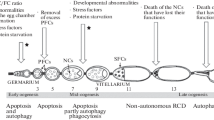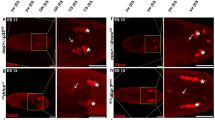Abstract
In Drosophila, the checkpoint protein-2 kinase (DmChk2) and its downstream effector protein, Dmp53, are required for DNA damage-mediated cell cycle arrest, DNA repair and apoptosis. In this study we focus on understanding the function of these two apoptosis inducing factors during ovarian development. We found that expression of Dmp53, but not DmChk2, led to loss of ovarian stem cells. We demonstrate that expression of DmChk2, but not Dmp53, induced mid-oogenesis cell death. DmChk2 induced cell death was not suppressed by Dmp53 mutant, revealing for the first time that in Drosophila, over-expression of DmChk2 can induce cell death which is independent of Dmp53. We found that over-expression of caspase inhibitors such as DIAP1, p35 and p49 did not suppress DmChk2- and Dmp53-induced cell death. Thus, our study reveals stage-specific effects of Dmp53 and DmChk2 in oogenesis. Moreover, our results demonstrate that although DmChk2 and Dmp53 affect different stages of ovarian development, loss of ovarian stem cells by p53 expression and mid-oogenesis cell death induced by DmChk2 do not require caspase activity.








Similar content being viewed by others
References
Stracker TH, Usui T, Petrini JH (2009) Taking the time to make important decisions: the checkpoint effector kinases Chk1 and Chk2 and the DNA damage response. DNA Repair (Amst). 8:1047–1054
Hirao A, Cheung A, Duncan G, Girard PM, Elia AJ, Wakeham A et al (2002) Chk2 is a tumor suppressor that regulates apoptosis in both an ataxia telangiectasia mutated (ATM)-dependent and an ATM-independent manner. Mol Cell Biol 22:6521–6532
Takai H, Naka K, Okada Y, Watanabe M, Harada N, Saito S et al (2002) Chk2-deficient mice exhibit radioresistance and defective p53-mediated transcription. EMBO J 21:5195–5205
Chen L, Gilkes DM, Pan Y, Lane WS, Chen J (2005) ATM and Chk2-dependent phosphorylation of MDMX contribute to p53 activation after DNA damage. EMBO J 24:3411–3422
LeBron C, Chen L, Gilkes DM, Chen J (2006) Regulation of MDMX nuclear import and degradation by Chk2 and 14-3-3. EMBO J 25:1196–1206
Pereg SY, Lam A, Teunisse S, Biton E, Meulmeester L, Mittelman G et al (2006) Differential roles of ATM- and Chk2-mediated phosphorylations of Hdmx in response to DNA damage. Mol Cell Biol 26:6819–6831
Yang S, Kuo C, Bisi JE, Kim MK (2002) PML-dependent apoptosis after DNA damage is regulated by the checkpoint kinase hCds1/Chk2. Nat Cell Biol 4:865–870
Brodsky MH, Nordstrom W, Tsang G, Kwan E, Rubin GM, Abrams JM (2000) Drosophila p53 binds a damage response element at the reaper locus. Cell 101:103–113
Ollmann M, Young LM, Di Como CJ, Karim F, Belvin M, Robertson S et al (2000) Drosophila p53 is a structural and functional homolog of the tumor suppressor p53. Cell 101:91–101
Jin S, Martinek S, Joo WS, Wortman JR, Mirkovic N, Sali A et al (2000) Identification and characterization of a p53 homologue in Drosophila melanogaster. Proc Natl Acad Sci USA 97:7301–7306
Fan Y, Lee TV, Xu D, Chen Z, Lamblin AF, Steller H et al (2010) Dual roles of Drosophila p53 in cell death and cell differentiation. Cell Death Differ 17:912–921
Wells BS, Yoshida E, Johnston LA (2006) Compensatory proliferation in Drosophila imaginal discs requires Dronc-dependent p53 activity. Curr Biol 16:1606–1615
Bauer JH, Chang C, Morris SN, Hozier S, Andersen S, Waitzman JS et al (2007) Expression of dominant-negative Dmp53 in the adult fly brain inhibits insulin signaling. Proc Natl Acad Sci USA 104:13355–13360
Yamada Y, Davis KD, Coffman CR (2008) Programmed cell death of primordial germ cells in Drosophila is regulated by p53 and the Outsiders monocarboxylate transporter. Development 135:207–216
Lu WJ, Chapo J, Roig I, Abrams JM (2010) Meiotic recombination provokes functional activation of the p53 regulatory network. Science 328:1278–1281
Xu J, Xin S, Du W (2001) Drosophila Chk2 is required for DNA damage-mediated cell cycle arrest and apoptosis. FEBS Lett 508:394–398
Peters M, DeLuca C, Hirao A, Stambolic V, Potter J et al (2002) Chk2 regulates irradiation-induced, p53-mediated apoptosis in Drosophila. Proc Natl Acad Sci USA 99:11305–11310
Brodsky MH, Weinert BT, Tsang G, Rong YS, McGinnis NM, Golic KG et al (2004) Drosophila melanogaster MNK/Chk2 and p53 regulate multiple DNA repair and apoptotic pathways following DNA damage. Mol Cell Biol 24:1219–1231
Xu J, Du W (2003) Drosophila chk2 plays an important role in a mitotic checkpoint in syncytial embryos. FEBS Lett 545:209–212
Masrouha N, Yang L, Hijal S, Larochelle S, Suter B (2003) The Drosophila chk2 gene loki is essential for embryonic DNA double-strand-break checkpoints induced in S phase or G2. Genetics 163:973–982
Takada S, Kelkar A, Theurkauf WE (2003) Drosophila checkpoint kinase 2 couples centrosome function and spindle assembly to genomic integrity. Cell 113:87–99
Abdu U, Brodsky M, Schupbach T (2002) Activation of a meiotic checkpoint during Drosophila oogenesis regulates the translation of Gurken through Chk2/Mnk. Curr Biol 12:1645–1651
Staeva-Vieira E, Yoo S, Lehmann R (2003) An essential role of DmRad51/SpnA in DNA repair and meiotic checkpoint control. EMBO J 22:5863–5874
Klattenhoff C, Bratu DP, McGinnis-Schultz N, Koppetsch BS, Cook HA, Theurkauf WE (2007) Drosophila rasiRNA pathway mutations disrupt embryonic axis specification through activation of an ATR/Chk2 DNA damage response. Dev Cell 12:45–55
Chen Y, Pane A, Schüpbach T (2007) Cutoff and aubergine mutations result in retrotransposon upregulation and checkpoint Activation in Drosophila. Curr Biol 17:1–6
Pane A, Wehr K, Schüpbach T (2007) Zucchini and squash encode two putative nucleases required for rasiRNA production in the Drosophila germline. Dev Cell 12:851–862
Rong YS, Titen SW, Xie HB, Golic MM, Bastiani M, Bandyopadhyay P et al (2002) Targeted mutagenesis by homologous recombination in D. melanogaster. Genes Dev 16:1568–1581
Juhász G, Erdi B, Sass M, Neufeld TP (2007) atg7-Dependent autophagy promotes neuronal health, stress tolerance, and longevity but is dispensable for metamorphosis in Drosophila. Genes Dev 21:3061–3066
Peterson JS, Barkett M, McCall K (2003) Stage-specific regulation of caspase activity in Drosophila oogenesis. Dev Biol 260:113–123
Queenan AM, Ghabrial A, Schüpbach T (1997) Ectopic activation of torpedo/Egfr, a Drosophila receptor tyrosine kinase, dorsalizes both the eggshell and the embryo. Development 124(19):3871–3880
Cox RT, Spradling AC (2003) A Balbiani body and the fusome mediate mitochondrial inheritance during Drosophila oogenesis. Development 130:1579–1590
Spradling AC (1986) P element-mediated transformation. In: Roberts DB (ed) Drosophila—a practical approach. IRL Press, Oxford, pp 175–197
McCall K, Pritchett TL, Peterson JS (2009) Detection of cell death in Drosophila. In: Erhardt P, Toth A (eds) Apoptosis: methods and protocol, 2nd edn. Methods in molecular biology, vol 559, pp 343–356
Bass BP, Tanner EA, Mateos San Martín D, Blute T, Kinser RD et al (2009) Cell-autonomous requirement for DNaseII in non-apoptotic cell death. Cell Death Differ 16:1362–1371
Brand AH, Perrimon N (1993) Targeted gene expression as a means of altering cell fates and generating dominant phenotypes. Development 118:401–415
Rorth P (1998) Gal4 in the Drosophila female germline. Mech Dev 78:113–118
Van Doren M, Williamson AL, Lehmann R (1998) Regulation of zygotic gene expression in Drosophila primordial germ cells. Curr Biol 8:243–246
Chao S, Nagoshi RN (1999) Induction of apoptosis in the germline and follicle layer of Drosophila egg chambers. Mech Dev 88:159–172
Baum JS, Arama E, Steller H, McCall K (2007) The Drosophila caspases strica and dronc function redundantly in programmed cell death during oogenesis. Cell Death Differ 14:1508–1517
Zoog SJ, Schiller JJ, Wetter JA, Chejanovsky N, Friesen PD (2002) Baculovirus apoptotic suppressor P49 is a substrate inhibitor of initiator caspases resistant to P35 in vivo. EMBO J 21:5130–5140
Jabbour AM, Ekert PG, Coulson EJ, Knight MJ, Ashley DM, Hawkins CJ (2002) The p35 relative, p49, inhibits mammalian and Drosophila caspases including DRONC and protects against apoptosis. Cell Death Differ 9:1311–1320
Rusten TE, Lindmo K, Juhasz G, Sass M, Seglen PO, Brech A, Stenmark H (2004) Programmed autophagy in the Drosophila fat body is induced by ecdysone through regulation of the PI3K pathway. Dev Cell 7:179–192
Hou YC, Chittaranjan S, Barbosa SG, McCall K, Gorski SM (2008) Effector caspase Dcp-1 and IAP protein Bruce regulate starvation-induced autophagy during Drosophila melanogaster oogenesis. J Cell Biol 182:1127–1139
Nezis IP, Lamark T, Velentzas AD, Rusten TE, Bjorkoy G, Johansen T et al (2009) Cell death during Drosophila melanogaster early oogenesis is mediated through autophagy. Autophagy 5:298–302
Terashima J, Bownes M (2005) A microarray analysis of genes involved in relating egg production to nutritional intake in Drosophila melanogaster. Cell Death Differ 12:429–440
Kroemer G, Galluzzi L, Vandenabeele P, Abrams J, Alnemri ES, Baehrecke EH et al (2009) Classification of cell death: recommendations of the Nomenclature Committee on Cell Death. Cell Death Differ 16:3–11
Starz-Gaiano M, Lehmann R (2001) Moving towards the next generation. Mech Dev 105:5–18
Burnett C, Howard K (2003) Fly and mammalian lipid phosphate phosphatase isoforms differ in activity both in vitro and in vivo. EMBO Rep 4:793–799
Hanyu-Nakamura K, Kobayashi S, Nakamura A (2004) Germ cell-autonomous Wunen2 is required for germline development in Drosophila embryos. Development 131:4545–4553
Renault AD, Sigal YJ, Morris AJ, Lehmann R (2004) Soma-germ line competition for lipid phosphate uptake regulates germ cell migration and survival. Science 305:1963–1966
Sano H, Renault AD, Lehmann R (2005) Control of lateral migration and germ cell elimination by the Drosophila melanogaster lipid phosphate phosphatases Wunen and Wunen 2. J Cell Biol 171:675–683
Acknowledgments
We thank Trudi Schüpbach, Andreas Bergmann, Thomas Neufeld, Michael Brodsky and the Bloomington stock center for generously providing fly strains and reagents. This research was supported by Israel Cancer association grant (to UA) and NIH R01 GM60574 (to KM).
Author information
Authors and Affiliations
Corresponding author
Additional information
A. Bakhrat and T. Pritchett contribute equally for this study.
Electronic supplementary material
Below is the link to the electronic supplementary material.
Fig. S1
DmChk2 genetically interacts with Dmp53 in regulating apoptosis in the Drosophila eye. a–d Scanning electron micrographs of eyes from GMR-Gal4 flies crossed to a wild-type fly (a), UASp-DmChk2 fly (b), UASp-Dmp53 fly (c), or UASp-Dmp53 UASp-DmChk2 fly (d). Expression of DmChk2 in the Drosophila eye had no effect on eye morphology (Fig. 1b). We found that overexpression of Dmp53 in the eye using GMR-Gal4 result in a reduced eye size with partial fusion of the ommatidia and some remaining bristles due to apoptosis (Fig. 1c). Co-expression of DmChk2 and Dmp53 resulted in a considerably more severe phenotype with almost complete loss of the eye compared to flies expressing Dmp53 alone (Fig. 1d). We repeated these experiments using all of our transgenic flies and found similar phenotypes. (TIFF 1585 kb)
Rights and permissions
About this article
Cite this article
Bakhrat, A., Pritchett, T., Peretz, G. et al. Drosophila Chk2 and p53 proteins induce stage-specific cell death independently during oogenesis. Apoptosis 15, 1425–1434 (2010). https://doi.org/10.1007/s10495-010-0539-z
Published:
Issue Date:
DOI: https://doi.org/10.1007/s10495-010-0539-z




